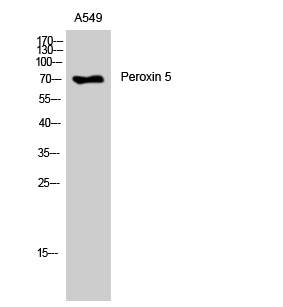Peroxin 5 Polyclonal Antibody
- 产品详情
- 实验流程
- 背景知识
Application
| WB |
|---|---|
| Primary Accession | P50542 |
| Reactivity | Human, Mouse |
| Host | Rabbit |
| Clonality | Polyclonal |
| Calculated MW | 70865 Da |
| Gene ID | 5830 |
|---|---|
| Other Names | PEX5; PXR1; Peroxisomal targeting signal 1 receptor; PTS1 receptor; PTS1R; PTS1-BP; Peroxin-5; Peroxisomal C-terminal targeting signal import receptor; Peroxisome receptor 1 |
| Dilution | WB~~Western Blot: 1/500 - 1/2000. ELISA: 1/40000. Not yet tested in other applications. |
| Format | Liquid in PBS containing 50% glycerol, 0.5% BSA and 0.09% (W/V) sodium azide. |
| Storage Conditions | -20℃ |
| Name | PEX5 {ECO:0000303|PubMed:10562279, ECO:0000312|HGNC:HGNC:9719} |
|---|---|
| Function | Receptor that mediates peroxisomal import of proteins containing a C-terminal PTS1-type tripeptide peroxisomal targeting signal (SKL-type) (PubMed:11101887, PubMed:11336669, PubMed:12456682, PubMed:16314507, PubMed:17157249, PubMed:17428317, PubMed:21976670, PubMed:26344566, PubMed:7706321, PubMed:7719337, PubMed:7790377). Binds to cargo proteins containing a PTS1 peroxisomal targeting signal in the cytosol, and translocates them into the peroxisome matrix by passing through the PEX13-PEX14 docking complex along with cargo proteins (PubMed:12456682, PubMed:17157249, PubMed:21976670, PubMed:26344566). PEX5 receptor is then retrotranslocated into the cytosol, leading to release of bound cargo in the peroxisome matrix, and reset for a subsequent peroxisome import cycle (PubMed:11336669, PubMed:24662292). |
| Cellular Location | Cytoplasm, cytosol. Peroxisome matrix. Note=Cycles between the cytosol and the peroxisome matrix (PubMed:11336669, PubMed:16314507). Following binding to cargo proteins containing a PTS1 peroxisomal targeting signal in the cytosol, recruited to the docking complex, composed of PEX13 and PEX14, leading to translocation into the peroxisome matrix along with cargo proteins (By similarity). Export and recycling to the cytosol is initiated by binding to the PEX2-PEX10- PEX12 ligase complex via its unstructured N-terminus that inserts into the ligase pore and emerges in the cytosol (By similarity). Cys-11 of PEX5 is then monoubiquitinated, promoting its extraction from peroxisomal membrane by the PEX1-PEX6 AAA ATPase complex (PubMed:16314507, PubMed:19208625, PubMed:24118911, PubMed:29884772) Extraction is accompanied by unfolding of the TPR repeats and release of bound cargo in the peroxisome matrix (By similarity). The TPR repeats refold in the cytosol and ubiquitination is removed by deubiquitinating enzymes, resetting PEX5 for a subsequent import cycle (By similarity). {ECO:0000250|UniProtKB:A0A1L8FDW4, ECO:0000269|PubMed:11336669, ECO:0000269|PubMed:16314507, ECO:0000269|PubMed:19208625, ECO:0000269|PubMed:24118911, ECO:0000269|PubMed:29884772} |
| Tissue Location | Detected in heart, brain, placenta, lung, liver, skeletal muscle, kidney and pancreas. |
Research Areas
For Research Use Only. Not For Use In Diagnostic Procedures.
Application Protocols
Provided below are standard protocols that you may find useful for product applications.
BACKGROUND
Binds to the C-terminal PTS1-type tripeptide peroxisomal targeting signal (SKL-type) and plays an essential role in peroxisomal protein import.
终于等到您。ABCEPTA(百远生物)抗体产品。
点击下方“我要评价 ”按钮提交您的反馈信息,您的反馈和评价是我们最宝贵的财富之一,
我们将在1-3个工作日内处理您的反馈信息。
如有疑问,联系:0512-88856768 tech-china@abcepta.com.























 癌症的基本特征包括细胞增殖、血管生成、迁移、凋亡逃避机制和细胞永生等。找到癌症发生过程中这些通路的关键标记物和对应的抗体用于检测至关重要。
癌症的基本特征包括细胞增殖、血管生成、迁移、凋亡逃避机制和细胞永生等。找到癌症发生过程中这些通路的关键标记物和对应的抗体用于检测至关重要。 为您推荐一个泛素化位点预测神器——泛素化分析工具,可以为您的蛋白的泛素化位点作出预测和评分。
为您推荐一个泛素化位点预测神器——泛素化分析工具,可以为您的蛋白的泛素化位点作出预测和评分。 细胞自噬受体图形绘图工具为你的蛋白的细胞受体结合位点作出预测和评分,识别结合到自噬通路中的蛋白是非常重要的,便于让我们理解自噬在正常生理、病理过程中的作用,如发育、细胞分化、神经退化性疾病、压力条件下、感染和癌症。
细胞自噬受体图形绘图工具为你的蛋白的细胞受体结合位点作出预测和评分,识别结合到自噬通路中的蛋白是非常重要的,便于让我们理解自噬在正常生理、病理过程中的作用,如发育、细胞分化、神经退化性疾病、压力条件下、感染和癌症。






